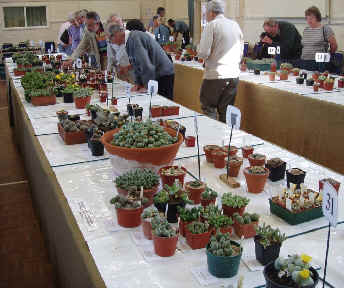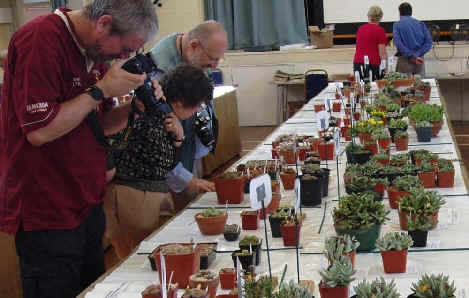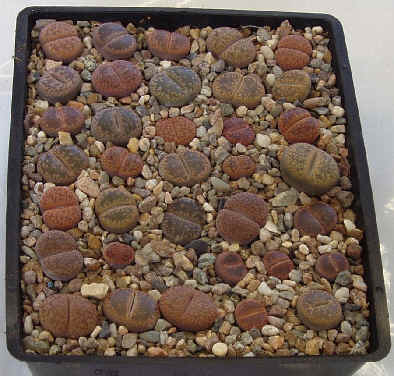

Contents of the Winter 2008 Northants News
|
MSG 2008 Event - A great day out Roland Tebbenham |
Every two years the Mesembryanthemaceae Study Group (MSG) holds an event offering a variety of diversions to interest those attending. The MSG is a well supported special interest group with a worldwide membership. On Saturday 27th September people gathered in a roomy hall in Banstead to enjoy a whole day devoted to their favourite plants. In the 2007 BCSS members survey Lithops were the favourite genus of the ‘Other Succulents’ with Conophytum seventh. Mesembs were second in the ‘Family League’ after the Aloeaceae. A dedicated team had set up display and sales tables so at 9:30 the car park filled up and members busied themselves unloading plants for display and sales as well as books and items for the auction and raffle.
This was an intensive period for me since I had transported around twenty display plants and nearly two hundred and fifty sales plants. Then it was time for an excellent bacon sandwich, courtesy of the dedicated catering team, and the first real chance to sit and chat with old friends. The event began in earnest at 11am. when there was a flurry of activity around the sales tables.
|
|
This was not a competitive show, but an exhibition arranged to encourage members to bring not only classic show plants, but also those less well-known, or examples of seedlings to show variation, photographs and the always fascinating class-50 - ‘The great Unnamed, or plants of Doubtful Identity’ – an opportunity to tap into the expertise of those present. There were entries in all classes, though some for Conophytum and Lithops were less well subscribed than in 2006. |
|
|
|
There was strong support for Cheiridopsis, Gibbaeum, in which Peter Bent brought his 30+ year old G. heathii (left), Pleiospilos, Glottiphyllum and Stomatium, which included a fine group of small plants again exhibited by Peter Bent. So there was a good mix of dwarf and shrubby plants for visitors to see and discuss. |
|
Suzanne Mace brought trays of Lithops schwantesii and Lithops aucampiae seedlings (below) showing considerable variation in body colours and patterns. Terry Smale exhibited a tray of seedlings in class-52 in an effort to discover whether other members had received seed of L. ‘Orange Ice’ or L. pseudotruncatella. He also showed that the MSG seedlings of L. ’Dintergreen’ are split evenly between the albino and normal forms. Many visitors were busy photographing the exhibits. The non-competitive exhibition did enable people to see some more unusual members of this large plant family. The other diversions included plant sales, book sales, a great raffle and an auction in aid of the MSG Research Fund. These activities were to be followed by a presentation delivered by a notable contributor to our understanding of the Mesemb family – of which more anon …
|
 |
Our Branch Sales Table was a great success and generated almost continuous interest for around four hours. Jeff Capel had done us proud by preparing various Mesembs and Adromischus (in accord with the South African flavor of the event), but it was our Lithops which proved to be the principal draw for customers. L. olivaceae ‘Red Olive’ and L. coleorum C396TL sold out quickly; L. werneri C188 also proved popular, which was fortunate since I had pricked out and grown on sixty plants to produce twenty pots each of three plants. One enthusiast purchased a mixed tray of twenty-four Lithops and enjoyed a 20% discount – Jeff and I do like bulk purchasers!
Following lunch the raffle was drawn, the income helping to defray the costs of staging the event. Then Terry Smale was the Auctioneer for plants, artwork, books, journals and even some German confectionary. Bidding was brisk for some rarer books and for four lots of Astrophytum hybrids (honorary Mesembs for the day). The MSG Research Fund ended better off by more than £400 – well done to the donors, buyers and auctioneer.
At 3:30 it was all hands on deck to clear the hall and reset it for the presentation, which started spot on time at 4:15. Dr Heidrun Hartmann has studied many aspects of Mesembs for more than forty years. Though of small stature she has enormous energy and knowledge, both were evident from her presentation. I heard her speak at the Fourth BCSS Convention at Reading in April 1998, when she spoke on ‘Climate and Adaptation in Mesembs’ and ‘New & Resurrected Genera in the Mesembs’ – both very interesting presentations. Her subject at Banstead was ‘Aizoaceae in Gauteng’ – or more specifically studies of Mesembs to be found in South Africa’s smallest province, in which the principal city is Johannesburg. Heidi spoke on aspects of taxonomy, DNA studies and the phytogeography of more than twenty taxa in six genera: Delosperma, Khadia, Frithia, Lithops, Mossia and Ruschia. One driving force for the work was the local Nature Conservancy organization which needed to understand which plants were endemic and their conservation status. Though my description might sound dry and scientific, Heidi’s presentation was very accessible and interesting: a tribute to her enthusiasm, photography and clarity of explanation.
Heidi outlined the significant distinguishing morphological features of some Delosperma species and related them to the findings of DNA studies. This enabled her to clarify which six species were distinct, endemic and that all needed protection in Gauteng Province and some adjacent territories.
There are two species of Frithia – F. pulchra with smooth body faces and F. humilis with rougher body faces. Their flowers exhibit quite different petal counts (F. pulchra - 36, F. humilis - 28) and Heidi requested that we perform counts on our own plants and send her the results.
Khadia is a genus of dwarf succulents in which the many staminodes initially form a cone over the stigmas; they open out as the flower matures and the stigmas become receptive to pollen. From habitat studies they are endangered. Heidi showed some detailed pictures of their growth habits, distinguishing characteristics and floral development. By contrast Mossia does not require protection owing to its wide distribution extending into Lesotho, Free State and Northern Cape. It grows in shallow soils on flat sandstone plates and receives periodic inundation. It can be grown as a hanging basket plant with nocturnal flowers.
Lithops lesliei is awkward to locate in its habitat in alkaline pans amongst grasses since it is quite cryptic. It is not endangered, but Heidi widened the discussion of whether particular varieties should be considered for protection. One example is L. lesliei v. rubrobrunnea, on which more work is needed.
The presentation concluded with remarks on Ruschia hamata, which has interesting rugose leaves with hooked ends, but is insufficiently separated from other species. Ruschia species have particular soil requirements – some acid, others alkaline. Again more work is needed. Heidi showed plots of her own observations of many Mesemb taxa overlaid on maps of Gauteng, South Africa and the entire African continent. She said that there is no substitute for field observation! Also good recording is essential to our understanding of plant distribution and relationships.
This was a fascinating ninety minute presentation on inter-related aspects of plant studies and thoroughly deserving of the generous vote of thanks given by Terry Smale. It was the highlight of a well organized event and I add my thanks to all those who organized it and helped in many ways. I hope I shall see lots of you at the next one. Don’t worry if you are not keen on all the Mesembs, you will be enthralled by many more of them if you attend in 2010!
Roland